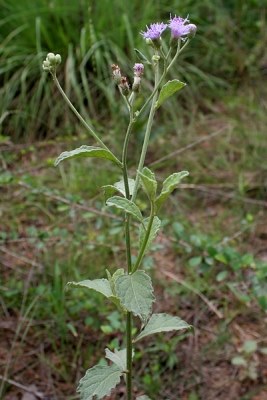Vernonia cinerea

|
|
Vernonia cinerea Common Names: Purple Fleabane, Little Ironweed,
Ash-Colored Fleabane, Sahadevi Scientific
Classification Kingdom: Plantae Clade: Tracheophytes Clade: Angiosperms Clade: Eudicots Clade: Asterids Order: Asterales Family: Asteraceae Genus: Vernonia Species: V. cinerea Binomial Name: Vernonia cinerea (L.) Less. Synonyms: Cyanthillium cinereum (L.) H.Rob., Conyza cinerea L. Morphological Description Vernonia cinerea, commonly known as Purple Fleabane or Little Ironweed, is an
erect annual or short-lived perennial herb, typically 0.2–1 m tall. It is
characterized by: · Stems: Ribbed, slender, covered with short, fine, grayish-white
hairs · Leaves: Variable, elliptic to lanceolate, 2–6 cm long, 1–3 cm wide,
with entire or slightly toothed margins, pubescent beneath · Flowers: Small, tubular, purple to lilac, 5–7 mm long, in dense terminal
heads, blooming year-round in tropics · Fruit: Achenes, 1–2 mm long, with a white pappus aiding wind
dispersal Its ash-gray appearance
inspires its specific epithet "cinerea," from Latin for ash (Trang et
al., 2024). Distribution and Habitat Vernonia cinerea is widely distributed across tropical and subtropical
regions, including Southeast Asia (e.g., Thailand, Malaysia), South America
(e.g., Brazil), Africa (e.g., Nigeria, Kenya), and parts of India and
Australia. It thrives in: · Habitats: Open fields, grasslands, roadsides, wastelands, and
disturbed sites · Climate: Warm, humid conditions with rainfall of 800–2,000 mm
annually, temperatures of 20–35°C · Soil Conditions: Adapts to sandy, loamy, or clay soils (pH
5.0–7.5), often in nutrient-poor areas · Elevation: Sea level to 1,500 m Its weedy nature allows
it to colonize diverse environments (Orwa et al., 2009). Ethnopharmacology Vernonia cinerea , commonly known as grey rabbitbrush or bitter daisy, is a
medicinal plant found in tropical and subtropical regions, particularly in Asia
and Africa. It has been used in traditional medicine for its antimicrobial,
anti-inflammatory, antioxidant, antidiabetic, analgesic, hepatoprotective, and
antipyretic properties. Various parts of the plant, including the leaves,
stems, and flowers, are used to treat a range of ailments such as fevers,
diarrhea, infections, gastrointestinal disorders, wounds, and pain. The plant
has also been used in the management of respiratory diseases, skin conditions,
and coughs. Phytochemical studies have identified compounds such as flavonoids,
saponins, terpenoids, alkaloids, and tannins, which are believed to contribute
to its medicinal effects. Though its use is supported by traditional knowledge
and some laboratory findings, more clinical studies are needed to validate its
therapeutic potential and ensure safety. · Antimalarial: Leaf infusions reduce *Plasmodium falciparum* growth (IC₅₀
15 µg/mL), used in Thailand for malaria (Chea et al., 2006). · Anti-inflammatory: Methanol extracts reduce edema in rats
(62% at 300 mg/kg), used in India for swelling (Mazumder et al., 2003). · Antidiabetic: Ethanol extracts lower blood glucose in rats (25% at 250
mg/kg), used in Nigeria for diabetes (Dogra & Kumar, 2015). · Antioxidant: Leaf fractions show DPPH scavenging (IC₅₀ 12 µg/mL), used in
Malaysia for oxidative stress (Sonibare et al., 2016). · Anticancer: DCM fraction induces apoptosis in HeLa cells (IC₅₀ 20
µg/mL), used in Ayurveda for tumors (Beeran et al., 2014). · Antimicrobial: Chloroform extracts inhibit *S. aureus* (MIC 0.5 mg/mL),
used in Sri Lanka for infections (Sonibare et al., 2016). · Renoprotective: Aqueous extracts protect kidneys. · Gastrointestinal Treatment: Root decoctions relieve dysentery in
Nepal, with tannins reducing inflammation (Dogra & Kumar, 2015). ⚠ Toxicity Profile: Acute toxicity study on mice, the median lethal
dose (LD50) of the extract exceeded 2000 mg/kg, and no pathological changes
were observed during the necropsy of treated mice. In addition to the oral
acute toxicity study, a brine shrimp lethality test was also conducted. The
LC50 values for the brine shrimp test were 3.87 mg/mL at 6 hours and 2.72 mg/mL
at 24 hours, showing no significant toxicity. (Latha, et al., 2010). Phytochemistry The plant’s medicinal
properties are driven by a diverse phytochemical profile: · Sesquiterpene Lactones: Vernolide, hirsutinolides, with
antimalarial and anticancer effects · Flavonoids: Luteolin, quercetin, providing antioxidant and
anti-inflammatory benefits · Triterpenes: β-Amyrin, linked to renoprotective properties · Phenolics: Caffeic acid, supporting antimicrobial actions · Steroids: Stigmasterol, contributing to anti-inflammatory effects Over 92 compounds have
been identified via GC-MS and LC-MS (Trang et al., 2024). Additional Uses · Ethnoveterinary: Leaves fed to livestock in Nigeria for
deworming (Yeap et al., 2010) · Smoking Cessation: Aerial parts used in Thailand to reduce
nicotine cravings · Topical Uses: Leaf juice applied to wounds in India for healing (Dogra
& Kumar, 2015) · Cultural Uses: Used in Ayurvedic rituals in India for purification References
External Links More Pictures |
|
| Compounds of Vernonia cinerea | |
| References |